| advanced |
TUTORIALS
- ARTS/125
- BCOM/231
- BCOM/275
- BIS/221
- BIS/221 T (NEW)
- BSA/310
- BSA/375 (NEW)
- BSA/376
- BSA/385 (NEW)
- BSA/515 (NEW)
- BSA/520 (NEW)
- BSA/525 (NEW)
- BSA/550 (NEW)
- BSCOM/100
- BUS/210
- BUS/212 (NEW)
- BUS/475 T (NEW)
- CIS/207 T (NEW)
- CIS/291
- CMGT/245 (NEW)
- CMGT/400 (NEW)
- CMGT/410 (NEW)
- CMGT/430
- CMGT/431 (NEW)
- CMGT/433 (NEW)
- CMGT/442 (NEW)
- CMGT/445 (NEW)
- CMGT/545 (NEW)
- CMGT/582 (NEW)
- CMGT/583 (NEW)
- COM/295
- COM/295 T (NEW)
- CSS/422 (NEW)
- CYB/110 (NEW)
- DBM/380
- ECO/365
- ECO/365 T (NEW)
- ECO/372
- ECO/372 T (NEW)
- ENG/220
- ENG/222
- ENG/223
- ENV/100
- ENV/410 (NEW)
- ETH/321
- ETH/321 T (NEW)
- FIN/370 T (NEW)
- HCS/405
- HCS/440
- HCS/451
- HCS/490
- HRM/300
- HRM/300 T (NEW)
- HRM/324
- HRM/498
- HUM/115 (NEW)
- HUM/186
- IT/200 (NEW)
- LDR/300
- LDR/300 T (NEW)
- LDRCB/535 (NEW)
- MBL/400 (NEW)
- MGT/312 T (NEW)
- MGT/362
- MGT/362 T (NEW)
- MGT/426
- MGT/498 (NEW)
- MGT/526 (NEW)
- MGTCB/526 (NEW)
- MKT/421
- MKT/421 T (NEW)
- MKT/441
- MTH/221
- NTC/255 (NEW)
- NTC/300 (NEW)
- NTC/302 (NEW)
- NTC/320
- NTC/324 (NEW)
- NTC/326
- NTC/328 (NEW)
- NTC/362 (NEW)
- NTC/409 (NEW)
- OPS/330 T (NEW)
- OPSCB/574 (NEW)
- ORGCB/535 (NEW)
- PHL/320 (NEW)
- PM/350 T (NEW)
- POS/355
- POS/408 (NEW)
- POS/408 T (NEW)
- POS/409
- PRG/211
- PRG/215
- PRG/218
- PRG/410 (NEW)
- PRG/420
- PRG/421
- PSY/300 (NEW)
- QNT/275
- SCI/220
- SOC/100
- SOC/110 (NEW)
CMGT/400 Intro to Information
Assurance & Security |
||
| Or you may purchase tutorials by the Week below. | ||
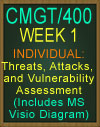 |
 |
 |
CMGT/400 WEEK 1
Everything Listed for Week 1 is included in Tutorial purchase!
Individual: Threats, Attacks, and Vulnerability Assessment Includes: Assessment Paper Includes: Microsoft Visio Diagram (fully editable diagram!) Includes: Discussion Questions Submit the assignment. Discussion Question: Penetration Testing Includes 3 Full Answers to Discussion Question! A+ Work! Penetration testers specialize in analyzing an organization for the purpose of making an authorized simulated attack on the organization's IT systems, to evaluate the security of its IT systems. The ability to analyze an organization's security and make authorized simulated attacks on it, to identify security risks, is a useful skill for anyone involved in cybersecurity to develop--not just penetration testers. This week you will select an organization you wish to explore throughout the course. Discuss how you will analyze the security of the organization prior to conducting a penetration test. Why is it important to gain authorization before you conduct a penetration test? How do you plan to attack the organization's IT systems? How will you report vulnerabilities which you identify back to the organization? Discussion Question: Threats and Vulnerability Scanning Includes 3 Full Answers to Discussion Question! A+ Work! Open Vulnerability Assessment System (OpenVAS) is free software that draws on a database of known vulnerabilities for various types of network devices. The software scans the network and collects information by monitoring various open ports to determine whether a given host is vulnerable to any of the known security threats. Based on the information collected, the vulnerability assessment software suggests solutions to address the detected vulnerabilities.
Discussion Question: Information Assets Includes 2 Full Answers to Discussion Question! A+ Work! How can information be an asset in a company? Discuss three different examples of information that should be protected by a company and not exposed. Include several examples of what management could do to protect each example.
Discussion Question: CIA Triad Includes 2 Full Answers to Discussion Question! A+ Work! Confidentiality, Integrity, and Availability are popularly known as the CIA Triad, often used to guide information security policy development. Explain how lack of security can cause availability to be impacted and why availability is important to an organization
|
||
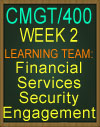 |
 |
 |
CMGT/400 Week 2Everything Listed for Week 2 is included in Tutorial purchase!
Learning Team: Financial Service Security Engagement and external employees as they use mobile devices
to access these applications. which runs the on-site applications. based CRM software provider uses appropriate physical security and environmental controls to protect their data centers which
run your cloud-based CRM software. cloud-based CRM. to increase security for these systems.
Individual: Penetration Testing Plan 8 Pages! A+ Work!! A Penetration Tester evaluates the security of an information
infrastructure by intentionally, and safely, exploiting vulnerabilities. can be the location of the teams involved with testing such as IT Operations. It's not uncommon for teams to operate in separate locations. Therefore, for this assignment the team location can be San Francisco, CA or it can be at the company headquarters such as Seattle, WA. This part is all fictional data so feel free to complete this portion of the assignment however you like. If you need ideas, you can look at larger public companies such as Amazon, Google, Microsoft, Apple, etc. as they tend to share a good deal of information on their websites about their organizations, office locations, corporate offices,
etc. government restrictions). Organization location can be the headquarters of the corporate office (e.g. Seattle, WA). options: Pentest Pre-Plan, plan the following pentest
execution activities wifi testing, physical security testing, social engineering testing. These are common scopes for real-world penetration testing. WA). Operations. It's not uncommon for teams to operate inseparate locations. Therefore, for this assignment the team location can be San Francisco, CA or it can be at the company headquarters such as Seattle, WA. This part is all fictional data so feel free to complete this portion of the assignment however you like. If you need ideas, you can look at larger public companies such as Amazon, Google, Microsoft, Apple, etc. as they tend to share a good deal of information on their websites about their organizations, office locations, corporate offices,
etc. Labor, Material, & Total Cost, here's what to
consider for each:
Discussion Question: Firewalls and Evasion Includes 3 Full Answers to Discussion Question! A+ Work! A firewall is a device that prevents unauthorized access to a host or a network either from within the corporate environment or coming from the public network, like the internet. Generally, there are two types of firewalls. A hardware firewall takes the form of a closed proprietary appliance with its own operating system. This is considered faster but a bit expensive. A software firewall is installed on a computer and it utilizes the computer's operating system.
Discussion Question: Mobile Device Security Includes 3 Full Answers to Discussion Question! A+ Work!Mobile device security continues to increase in importance and has become a key security focus as organizations and individuals protect their information assets and IT technology. Discuss how you would approach mobile device security for employees, customers, stakeholders, and partners as they use mobile devices to access technology and software applications in the organization you chose in Week 1?
Discussion Question: Audit Tools SSAE 16 is a popular tool for reporting on operational processes.
Discussion Question: Regulatory Standards Discuss regulatory standards such as those applicable to health care organizations. Why do you think they are needed? Who do they protect?
Discussion Question: Social Networking Discuss why an organization should worry about Social Networking. How can Social Networking have a positive or negative impact on the organization?
Discussion Question: Behavioral Roots of Information Security
Discussion Question: Security Approach for Small Healthcare Organizations
|
||
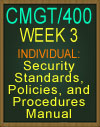 |
 |
 |
CMGT/400 Week 3
Everything Listed for Week 1 is included in Tutorial purchase!
Individual: Security Standards, Policies, and Procedures Manual and procedures. Discuss how security policies, plans, and procedures will improve the overall security of the organization. • Recommend appropriate policies and procedures for: Advisory, Informative]
Discussion Question: Industry and Government Regulations Includes 3 Full Answers to this Discussion Question! A+ Work! Research industry and government regulations in the context of the organization you chose in Week 1.
Discuss which resource(s) you found to be most useful in terms not only of researching the different types of industry
and government regulations that exist, but which industry and government regulations must be implemented for a given security scenario. Includes 3 Full Answers to this Discussion Question! A+ Work! Consider legal, ethical, and regulatory considerations of protecting data in the context of the organization you chose in
Week 1.
Discuss which resource(s) you found to be most useful in terms not only of researching the different types of legal,
ethical, and regulatory considerations of protecting data that exist, but also which legal, ethical, and regulatory
considerations of protecting data must be implemented for a given security scenario.
Discussion Question:Effective Controls of Health Care Information What are three controls that would be effective in protecting health care information?
Discussion Question: Access Control Methods Other access control methods an organization can use are listed below. These are "best practice" access controls that any organization, not just HIPAA-compliant healthcare systems, can benefit from.
Discussion Question:Vulnerabilities in virtualization and in the Cloud How can a company protect data on corporate laptops? Many companies now store their data in the cloud. Do you think that laptops working with virtualization and the cloud are in more danger than using a workstation? Explain why you think so.
Discussion Question:Corporate Laptop Protection How can a company protect data on corporate laptops? Why do more organizations choose not to protect such data? Do you expect this to become a legal requirement in the future? Explain why you think so.
Discussion Question:Data Recovery Organizations can have data stolen (e.g., through hacking), but if that happens, the organization will typically retain the data on their system. Discuss some steps to be taken which supports an organization that has lost data (e.g., the company data center burned down).
|
||
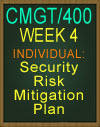 |
 |
|
| CMGT/400 Week 4
Individual: Security Risk Mitigation Plan Includes: Discussion Questions Security Policies and Controls [Response] Password Policies [Response] Administrator Roles and Responsibilities [Response] User Roles and Responsibilities [Response] Authentic Strategy [Response] Intrusion Detection and Monitoring Strategy [Response] Virus Detection Strategies and Protection [Response] Auditing Policies and Procedures Education Plan Develop an education plan for employees on security protocols and appropriate use. Risk Response Include: Avoidance, Transference, Mitigation, and Acceptance. Change Management/Version Control [Response] Acceptable Use of Organization Assets and Data [Response] Employee Policies Explain the separations of duties and training. Incident Response Document incident types and category definitions, roles and responsibilities, reporting requirements and escalation, and cyber-incident response teams. Incident Response Process Discuss the incident response process including: preparation, identification, containment, eradication, recovery, and lessons learned. [Response]
Learning Team Assignment not included
Discussion Question: Security Risk Management Plan
Discussion Question: Staff Awareness What recommendations do you have for a CISO tasked with increasing security awareness in your organization or an organization with which you are familiar?
Discussion Question:How to Protect Your Organization from Ransomware As our class discussions surfaced, ransomware is a growing risk with growing impact. In addition to training and awareness, currency and patching, organizations should "Manage the use of privileged accounts based on the principle of least privilege: no users should be assigned administrative access unless absolutely needed; and those with a need for administrator accounts should only use them when necessary." (How to Protect Your Networks, 2020). Check out the document at the following link to learn how to protect your organization from ransomware. Think about how these recommendations would influence the organization security policy and communication strategy.
Discussion Question:Encryption Some hurdles that an organization must overcome to successfully implement encryption are complicating data recovery and computer slow down. When data needs to be recovered on an encrypted drive its a good thing that the data is a bit more complicated to recover. Every time you try to access a file on an encrypted drive, the authentication key is required this process can slow down the computer.
|
||
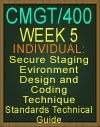 |
 |
|
CMGT/400 Week 5
Everything Listed for Week 5 is included in purchase!
Individual: Secure Staging Evironment Design and Coding Technique Standards Technical Guide Includes: Secure Staging Option #2 Includes: Microsoft Visio Diagram of Staging Environment (Fully editable)! Includes: All Discussion Questions and Answers! A Software Engineer designs, develop, tests, and evaluates the
software and the systems that allow computers to execute their
applications. covering the following secure coding techniques:
Discussion: Secure Application Development Includes 3 Full Answers to Discussion Question! A+ Work!! Application security is the use of hardware, software, and design, development, and implementation methods to create applications which are protected from cybersecurity threats. Discuss the methods that should be used during application design, build, and implementation to protect software applications from cybersecurity threats. What hardware and software resources can an organization implement to create more secure software applications?
Discussion: Embedded Systems
Discussion Question: Secure Software and Systems What are two of the best practices for developing secure software and systems? Why would each practice be suitable for an organization to implement to strengthen its information security posture? Describe the benefits of each.
Discussion Question: Threat Modeling Where should threat modeling be used in the system development process? Why is it so challenging for some individuals to understand? What can be done to make learning how to do it effectively easier?
Discussion Question: Internal Auditor The NIST handbook suggests that audit trails can assist with individual accountability, reconstruction of events, intrusion detection, and problem analysis. The audit trail logs user activities and can help managers promote proper user behavior since they know that their actions are being recorded. A reconstruction of events can review system activity to pinpoint how, when, and why normal operation ceased. This is also a benefit that can determine whether it was operator induced or system induced errors. Real-time auditing can help to pinpoint intrusions by unauthorized users. Problem analysis can be used to find non-intrusion problems. The system can be determined if it was damaged by user error or operational error. How would an internal auditor use these audit trails?
Discussion Question: Professional Education A prospective employer recruiting for a security role may get applications from people with a wide variety of backgrounds in terms of experience and education.
Discussion Question: Global Encryption Laws Encryption laws vary from country to county. According to Saper (2013), "In the United States, there are few restrictions on the use of cryptography. When operating overseas, however, companies must grapple with a bewildering array of regulations and restrictions on the use of cryptography. Some countries restrict the import or export of cryptographic technology, others restrict the import of encrypted data, and still others restrict or prohibit the use of encryption within their borders. These regulations create immense difficulties for firms attempting to operate overseas, especially where prohibitions on the use of encryption force them to put their intellectual property at risk of compromise."
Discussion Question: Cyber Incident Policy and Response Program Hospitals are an increasing target of cybercriminals including organized criminal gangs and ransomware. Although many organizations are developing security prevention and detection programs, a weakness in predefined incident response policies and processes exist. To reduce risk to hospital critical infrastructures, information assets and patients, Johns Hopkins has developed a robust security program including formal incident response protocols and processes.
|
||







